
Pandas: The Giant Vegetarian Nominal Predators That Have Just Escaped Extinction
All organisms are connected in what is known as the cycle of life, according to Mufasa, or the food chain, according to biologists. They all depend on one another. One living thing eats another, which eats another, and so on. Any disturbance in this cycle can potentially threaten the balance all organisms live in.
Having said that, there seems to be one animal that has partially broken free from its nature, like all the animals in Zootopia, without affecting the circle of life. That is the panda.
The giant, squishy, super cute, black and white panda.
The giant panda
Pandas often represent warm friendships. In Eastern cultures, they are a symbol of good fortune, peace, and happiness. And why not? Pandas do possess all the necessary traits for that. Their eyes look big, thanks to the black patches around them. Their ears and paws are small. They are round and chubby, and their bodies are covered with beautiful, fluffy black and white fur.
Besides, pandas almost never become aggressive despite what their large size may propose. They take things easy and avoid getting into fights with others. They also prefer to stay on their own and barely do any action except for eating and sleeping, which makes them, somehow, also symbolise laziness.
But those super cute, peaceful animals were marching steadily toward extinction. It was not until 2016 that a slight drift occurred in the way and relatively saved them from disappearance.
So what exactly is the story of the panda? What is it about it that makes it that utterly cute and loveable? And why is it endangered?
Well, this is precisely what we are tackling in today’s lesson.
So let’s hop into it.
Evolution
Typically, animals currently living on Earth are highly different from their ancestors, who lived millions of years ago. That is due to the extreme environmental changes they had gone through, which forced their bodies to adapt and therefore change.
For example, millions of years ago, whales used to be land animals, and they did have legs. Then at some point, they moved to the sea. Over time, they turned into water animals, and their feet eventually disappeared. The Valley of the Whales is a public park in Egypt’s Western Desert with the largest number of fossils belonging to those legged whales.
The giant panda is a member of the bear family or the Ursidae family, as known in zoology. In total, there are eight different bear species. Some of them may look somewhat similar, such as the American black bear and the Asian black bear.
One undoubted thing about the panda is how different it is from the rest of the bears. First, it is the only beat with a combination of two different fur colours and beautiful eye patches. In addition, the panda had apparently made some transformational decisions, which turned it into a nominal bear rather than an actual one.
For instance, all bears are carnivores. That means they eat meat only. So the panda is originally a carnivore; yet, it does not eat meat at all. Instead, it eats plants. More specifically, the panda specialises in eating leaves. Even more specifically, the panda eats bamboo, which makes up more than 97% of its diet.
This change in the panda’s diet is exotic and has confused biologists for so long. Instead of the meat that can sustain its health and physical strength, the panda traded it for something as low in nutritional value and impossible to digest as bamboo.
Another unusual thing about the panda is that it seems to have put its predatory instincts on the shelf and decided to become a super peaceful and cute bear instead. Well, that was an inevitable consequence of the panda abandoning the meat-based diet. Why would it attack other animals if it was not going to eat them? Makes sense, does it not?
So, the panda’s evolution was more like turning off some instincts and enjoying the changes that led to. An apex predator that attacks others and eats meat? No, the panda became a nominal predator that hardly ever attacks other animals and eats loads of bamboo.
Subspecies
Though one might think there is only one type of panda in the wild, in fact, there are two. These are called subspecies. The first subspecies is the most common black and white bear, the one we are all familiar with.
The other less-known subspecies is the Qinling panda. It diverged from the regular black and white panda around 300,000 years ago. Then, it evolved and changed a little; yet, it stayed recognisable as pandas.
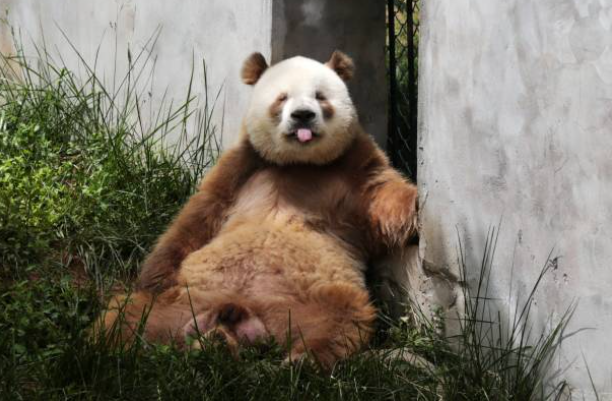
For instance, the Qinling panda is generally smaller than the giant panda. It is mainly characterised by its dark and light brown fur that replaced the black and white coat of the regular panda. Its eye patches are also different. While the giant panda has black patches all around the eyes, the Qinling panda only has brown patches under the eye.
Despite that, both pandas hold the same record for laziness as well as peacefulness.
Discovery
Pandas have been known to the Chinese people ever since both of them came across each other. However, the black and white bear, like the penguins, was not known to the Western World until 1869. So how was the panda introduced to the rest of the world?
In the mid-19th century, a French missionary named Armand David was on a journey in China. While he was there, he saw the panda for the first time but did not know what it was. Sp before heading back to France, he brought a dead preserved panda for zoologists to study.
At first, zoologists thought the panda looked like a cat, so they called it the black and white animal with the cat foot.
Interest in the panda grew, and many studies to understand what kind of animal it was were conducted. For a long time, the panda was thought to be related to the raccoon since both shared some physical characteristics. But it was not until 1970 that DNA testing proved the giant panda is a bear.
Name
Before we get into more detail, we must clarify that the panda is often called the giant panda. That is not because it has such a big body but to distinguish it from the red panda, which pretty much looks like a raccoon. That said, the red panda is not in any way related to the giant panda, nor is it a bear in the first place.
If that is the case, why would two unrelated animals hold the same name?
Well, here is how the story goes.
The red panda is a mammal native to Nepal, and it was discovered way before the giant panda. So the Nepalese people called the red panda ponya, which probably refers to its elongated wrist bone. Later on, ponya became panda in English, and the Western World used it to refer to the red panda.
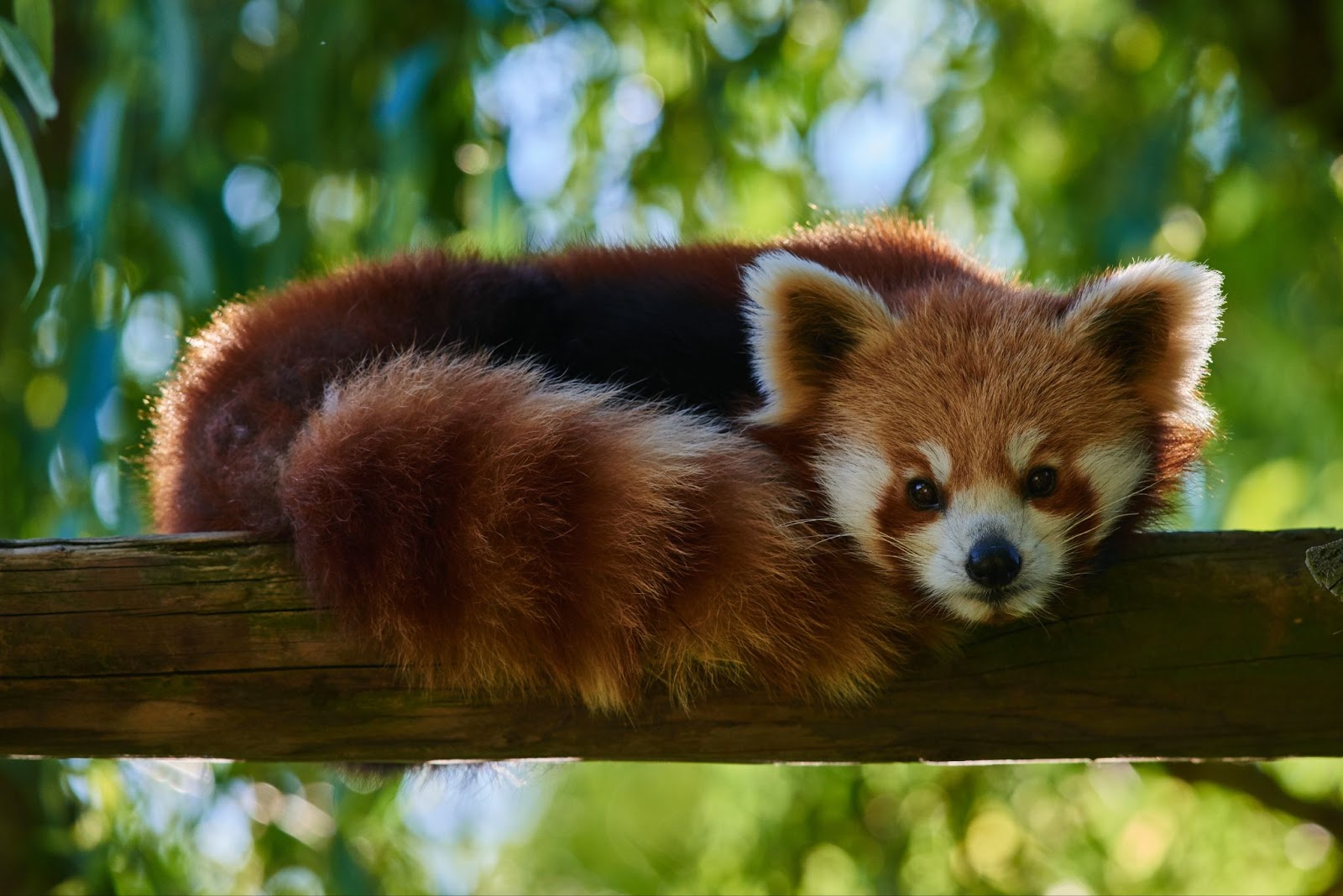
But then, the giant panda was introduced to the West. When they studied it, zoologists found out the giant panda had the same elongated wrist bone as the red panda. As a result, the newly discovered black and white bear was also named panda.
In order to distinguish between the two unrelated species, the Nepalese mammal was called the red panda, and the Chinese one became the giant panda.
Another theory claims that the giant panda and the red panda carry the same name because both of them eat bamboo. And the word panda, derived from ponya, is thought to mean ‘the bamboo eater’ in Nepali.
Yet, one cannot help but wonder: if the giant panda is native to China, what did the Chinese call it?
Well, the Chinese had as many as 20 different names for the giant panda. For centuries, they called it mò, which meant the giant panda. Other given names also meant the spotted bear, the bear cat, and the giant bear cat.
Anyways, since we now know the difference between the two mammals and as this article is about the Chinese, black and white bear, we are going to refer to the giant panda just as the panda.
Appearance
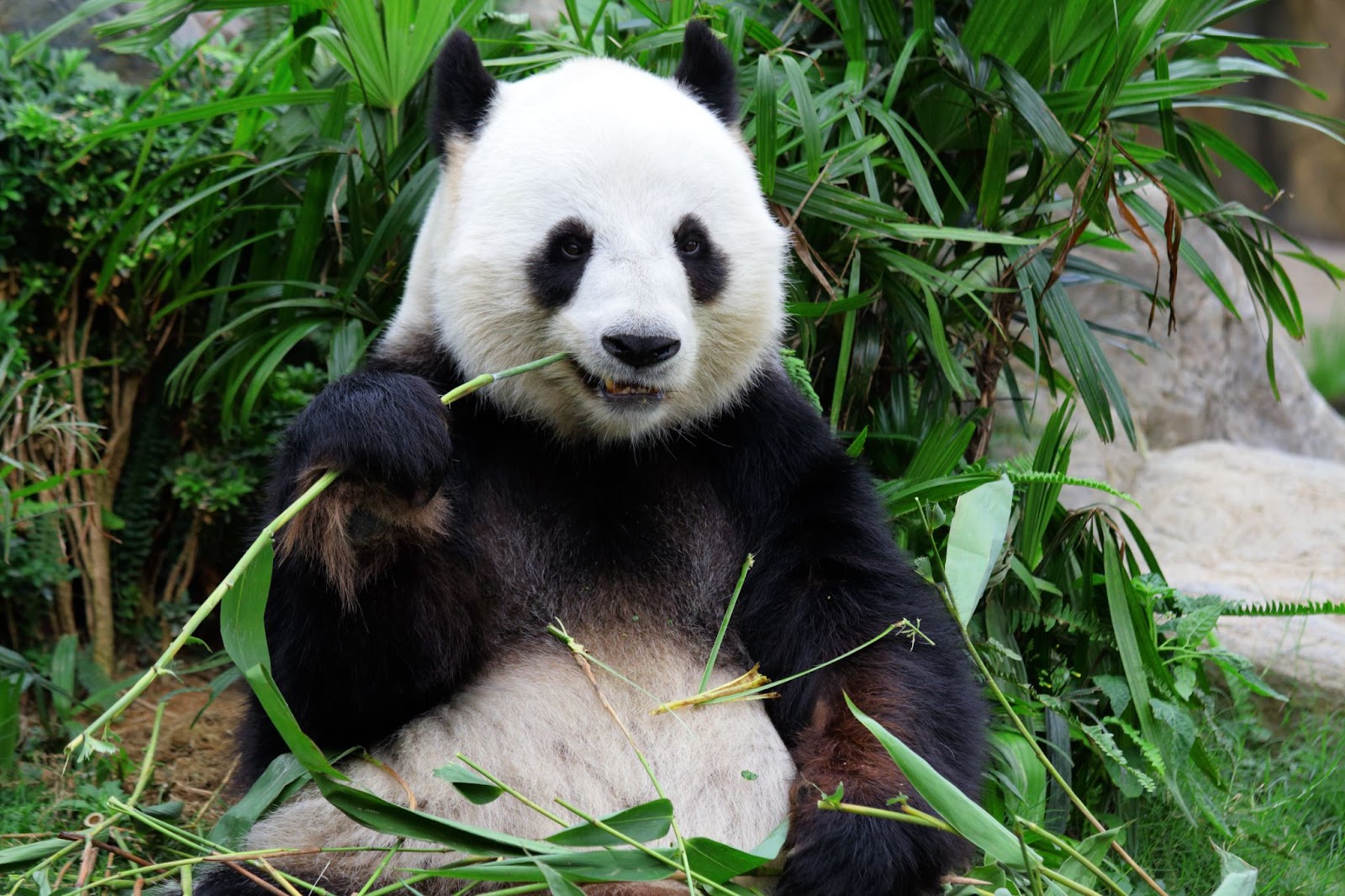
Bears may seem to have the same large body structure; however, their appearances are definitely diverse. But when it comes to which one is the cutest, the panda always wins first place.
Speaking of size, pandas were not called giants for nothing. Like every other bear in the Ursidae family, they are considerably large, with males being 10-20% larger than females.
By the way, male pandas are called boars, females are sows, and babies are cubs.
Male pandas weigh up to 160 kg, while females’ weight ranges between 70 and 125 kg. Both males and females are 1.2 to 1.9 metres long. The panda’s body is covered with a thick, woolly coat that keeps the bear warm in cold weather.
Like almost all mammals, the panda is warm-blooded. That means the bear’s body is designed to keep its temperature at a certain degree that is usually higher than the surroundings. So with the help of the thick fur coat, the panda stays pretty warm during winter.
Colour-wise, the fur is predominantly white, with the front and hind legs, shoulders, upper back, ears, and eye patches being black. The panda has a tail that is relatively long, at least compared to the rest of the bears. It typically measures between 10 and 15 cm.
Besides the distinct coat, another thing that is very special about the panda in its paws. The panda has five long fingers and a small bone called the sesamoid bone that looks like a thumb. Interestingly, the panda makes the best use of this bone as it helps it hold things, primarily bamboo branches.
Despite the panda mostly seen walking on all fours, it can easily stand upright on its hind legs. If you have watched the animated film Kung Fu Panda 3 (2016), in which Po finally meets his dad, you will recall that pandas love to roll and somersault, especially the young.
Feeding
As all animals are created with specific food preferences, their stomachs are designed accordingly to be able to digest that food. Animals that feed on plants only have stomachs that can break them down and turn them into energy. However, those stomachs cannot digest meat. And vice versa.
As we have mentioned, pandas are bears that underwent changes throughout their history, which is estimated to be millions of years. As they are initially meat eaters, their stomachs can perfectly digest meat and not plants.
So what happened that pandas abandoned meat altogether and traded it for bamboo? How could a meat-eater become a strict vegetarian even though its stomach cannot digest plants? According to scientists, this shift in the panda’s diet occurred 2.4 million years ago. So how could it survive all that time on something it cannot digest?
Well, the answers to these questions were not revealed until 2010 when a group of scientists from the University of Michigan found out what happened and caused this drastic change. It turns out it was all the fault of a specific genetic mutation. So let’s break it down.
Genetic mutation
All animals have taste buds in their tongues. These taste buds contain taste receptor cells. These cells can easily recognise the different tastes, from sweet and sour to salty and bitter. They can also identify the taste of meat, which is called umami.
Before the panda switched to bamboo, their taste receptors that recognised umami worked perfectly. But then, a genetic mutation caused these umami taste receptors to be inactive. So pandas could no longer taste meat.
In other words, meat has become tasteless to them. And honestly, who would still eat anything that does not taste like anything? Eventually, pandas stopped eating meat.
OK. Now we understand how meat was dropped from the panda’s diet. The next question is: why did it choose bamboo in particular, even though its nutritional value is minimal?
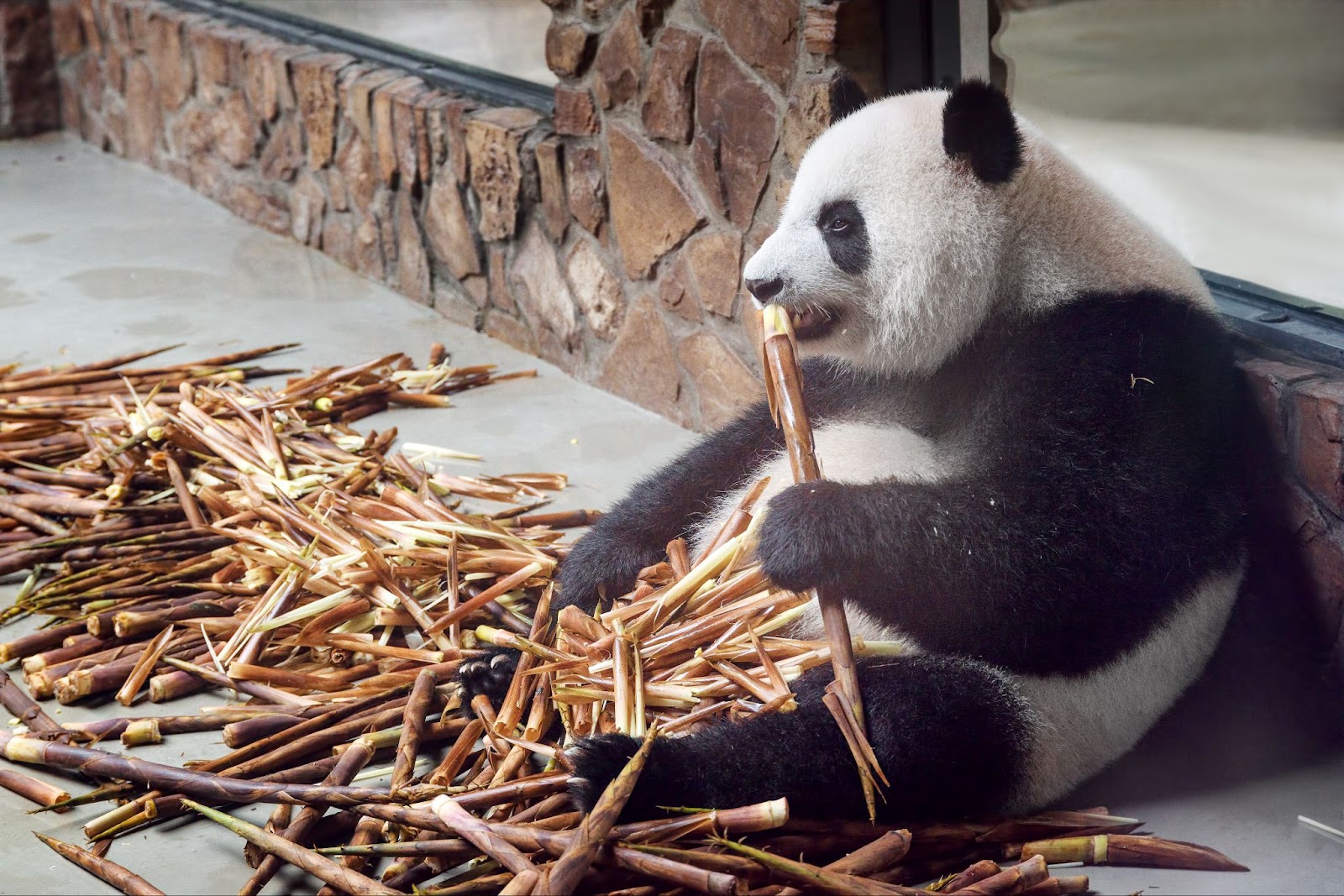
Well, apparently, pandas chose bamboo only because it is available everywhere in their natural habitat, all year long. They do not have to make a lot of physical effort to obtain it, nor do they need to compete over it with other animals.
So, in short, pandas seem to have chosen bamboo at the expense of eating healthy, nutritious food just out of laziness.
Now one problem remains. Although the panda already started eating bamboo millions of years ago, its stomach has not changed. The stomach that was designed to digest meat still cannot digest plants. So how could the panda survive on something it cannot digest?
Well, by overeating.
Bamboo is 60% cellulose, and the panda’s stomach, like that of any apex predator, cannot digest cellulose. The only useful part of bamboo that provides the panda with some nutrients is the shoots or the bamboo sprouts. These parts have a relatively high protein and starch content, the two things the panda’s stomach can digest.
So to maintain its health and get the minimum energy to go through the day, the panda eats large amounts of bamboo each day to compensate. In fact, the panda spends up to 16 hours a day eating what is equal to 12-38 kg of bamboo. And since more than half of bamboo is not digested, the panda has to go to the restroom up to 40 and sometimes even 50 times per day.
Though all bamboo might look the same to us, it is not. In fact, there are 25 different species of bamboo, and the panda eats all of them. That said, for the panda to survive and not starve, at least two of these bamboo species must be available in the panda’s natural habitat.
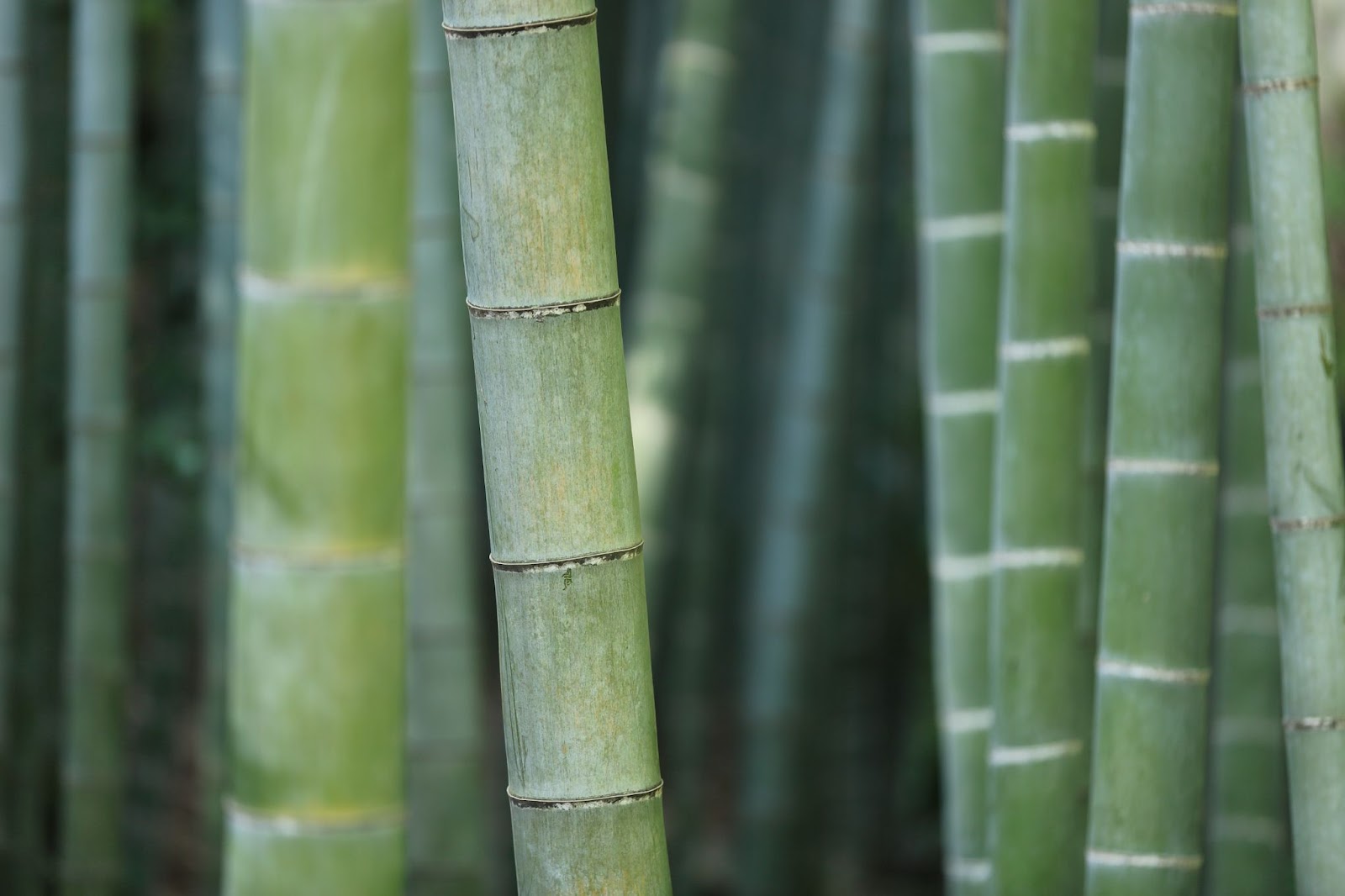
Besides bamboo, which is as fundamental for the panda as air, the cute black and white bear may also eat grass, fish, and maybe even rodents on rare occasions.
So, for millions of years, pandas have been taking it one day at a time.
Teeth
Interestingly, the panda’s teeth and jaw have changed and adapted to the new food preference. The jaw, supported by powerful muscles, became stronger, resulting in the panda having a round face.
And since bamboo is tough, as hard as wood, the panda’s front teeth became sharper, and the molar ones became broader and flat. It is said that the panda’s molar teeth are seven times as large as our molar teeth. With such a wide surface, and a strong jaw supported by muscles, the panda can easily chew bamboo up to four cm thick!
Like many other predators, the panda has sharp, pointed canine teeth initially intended to support the animal’s predatory nature. Other predators usually use their canine teeth to bite or stab prey to bring it down, kill it, and break its bones. Since the panda no longer needs to catch prey or tear meat, it seems like its canine teeth have become less important than its molar teeth.
Interestingly, pandas chew bamboo fast, which results in so much noise.
Stomach
Even though it does not digest bamboo, the panda’s stomach is still pretty powerful. In fact, if it had not been, all the bamboo that the panda consumed would have killed it, not due to its limited nutritional value but because of its cyanide content.
Cyanide is a toxic material. A large dose of it can poison the animal and kill it. Every day, up to 66.1 mg of cyanide gets into the panda’s system from the bamboo. This is quite a large quantity if you are wondering how effective it is. But the panda does not really have to worry much about it because its stomach takes care of the whole thing.
Interestingly, the panda’s stomach turns 80% of the cyanide into a non-toxic material and kicks it out of the body with urine. The rest of the cyanide is also detoxified and therefore becomes ineffective.
Behaviour
As we have said, many things have changed about the panda ever since it became a vegetarian. As the need for meat vanished, so did the bear’s predator instincts.
Likewise, feeding on bamboo only has imposed its own constraints. Although the panda eats large quantities of it daily, it only gets very little energy. Consequently, the panda decided to limit its movement and social interaction to the extreme minimum to preserve as much energy as possible.
Instead of a lifetime full of movement, adventures, and exploration, the panda decided it would sit down and chill most of the time it is meant to be alive. Even curiosity, one of the panda’s naturally embedded traits, will not force it to move.
Therefore, the panda has become so lazy that it competes with the sloth and the koala.
So we can take this as a general role. The panda deliberately switched off many of its super-duper predator capabilities and abandoned everything that may require physical activity.
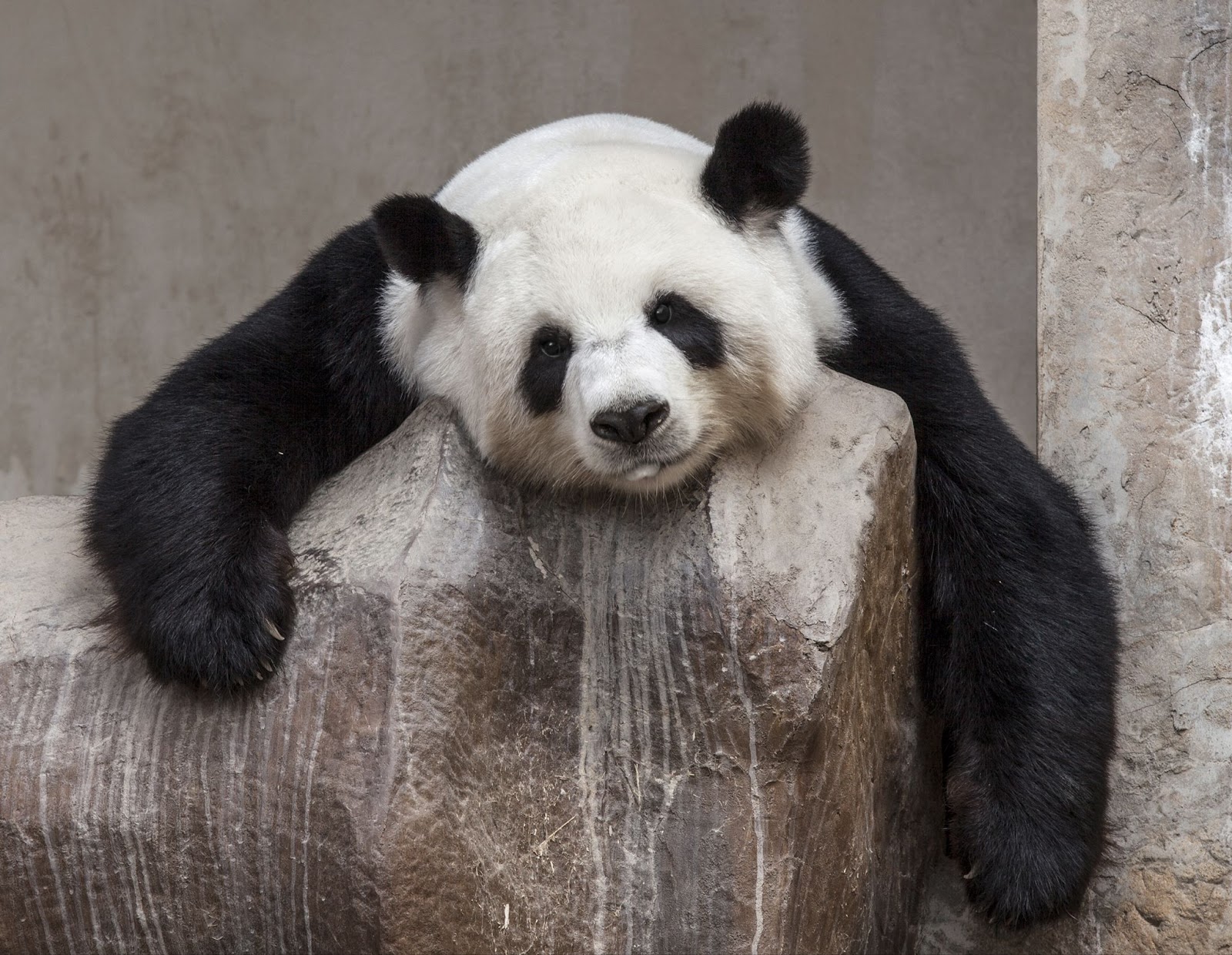
For instance, the panda can initially run at 32 km/h. That is close to the polar bear, which can run at 40 km/h. Setting the polar bear aside, travelling back in time might be more possible than a panda running!
Furthermore, the panda hates to walk and only does it to bring food. But even this urge will not motivate the panda to speed up. In fact, the panda only walks 27 metres per hour! This is pretty embarrassing for an originally predatory animal!
Similarly, pandas are good swimmers. But again, the bear will not swim under any condition. It may chill in the water and relax, but swim, as in to move front and back legs, no. That is no longer available. The panda is also a perfect tree climber. Yet, it will only force itself to climb a tree only when no food is available on the ground.
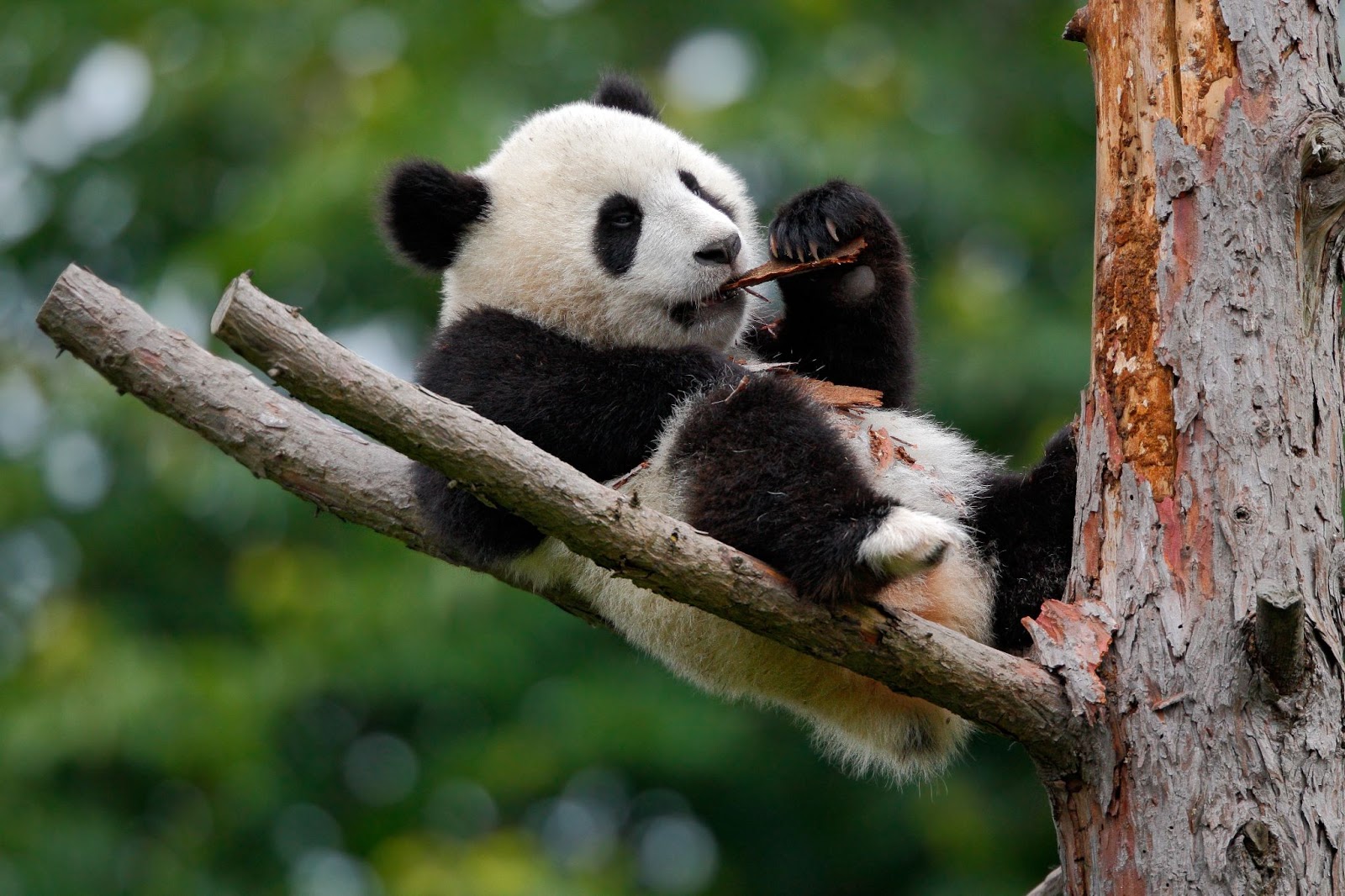
As a result of all that cutting down on physical activity, the panda is one of the very few animals that does not get any bothered when kept in captivity. Since it has committed to winning the world’s laziest animal title, it does not really care about staying in a zoo. No matter where it is, the panda will prefer to sit down and chill as long as there is a consistent food supply.
On the other hand, other animals, especially the hyperactive ones, hate to be imprisoned in cages or rooms, even if they are relatively wide. All animals feel much more comfortable in their natural habitat, where they are free to wander around and go wherever they want. Some of those animals may even feel depressed.
Theoretically speaking, the panda is an apex predator. It is placed right at the top of the food chain, side by side with the rest of the bears, big cats, wolves, hawks, and crocodiles. Accordingly, the panda has no natural predator. That means no other animals can feed on them.
However, pandas are prone to attacks in the wild by different degrees. For instance, predators such as snow leopards, feral dogs and even the panda’s cousin, the Asian black bear, may attack panda cubs. On the other hand, leopards might attack subadult pandas weighing up to 50 kg.
Adult pandas may be attacked sadly by humans.
Despite their little physical activity and aversion to walking, pandas are territorial.
Animals choose specific areas of their habitat as their homes. They define them using their body scents to inform other animals that these areas are privately owned. Well, the panda does the same thing.
Thanks to their commitment to preserving as much of their physical power as possible, pandas restrict their activity and, therefore, personal territory to only an area of 4 to 6 square km. To declare this area as home, the panda rubs its body against trees and rocks to leave behind its scent.
Pandas enjoy a powerful sense of smell. So when other pandas smell the scent, they get the message, choose peace over war, and stay away from the territory. Interestingly, pandas can tell whether a territory is male or female only from the scent.
Mating
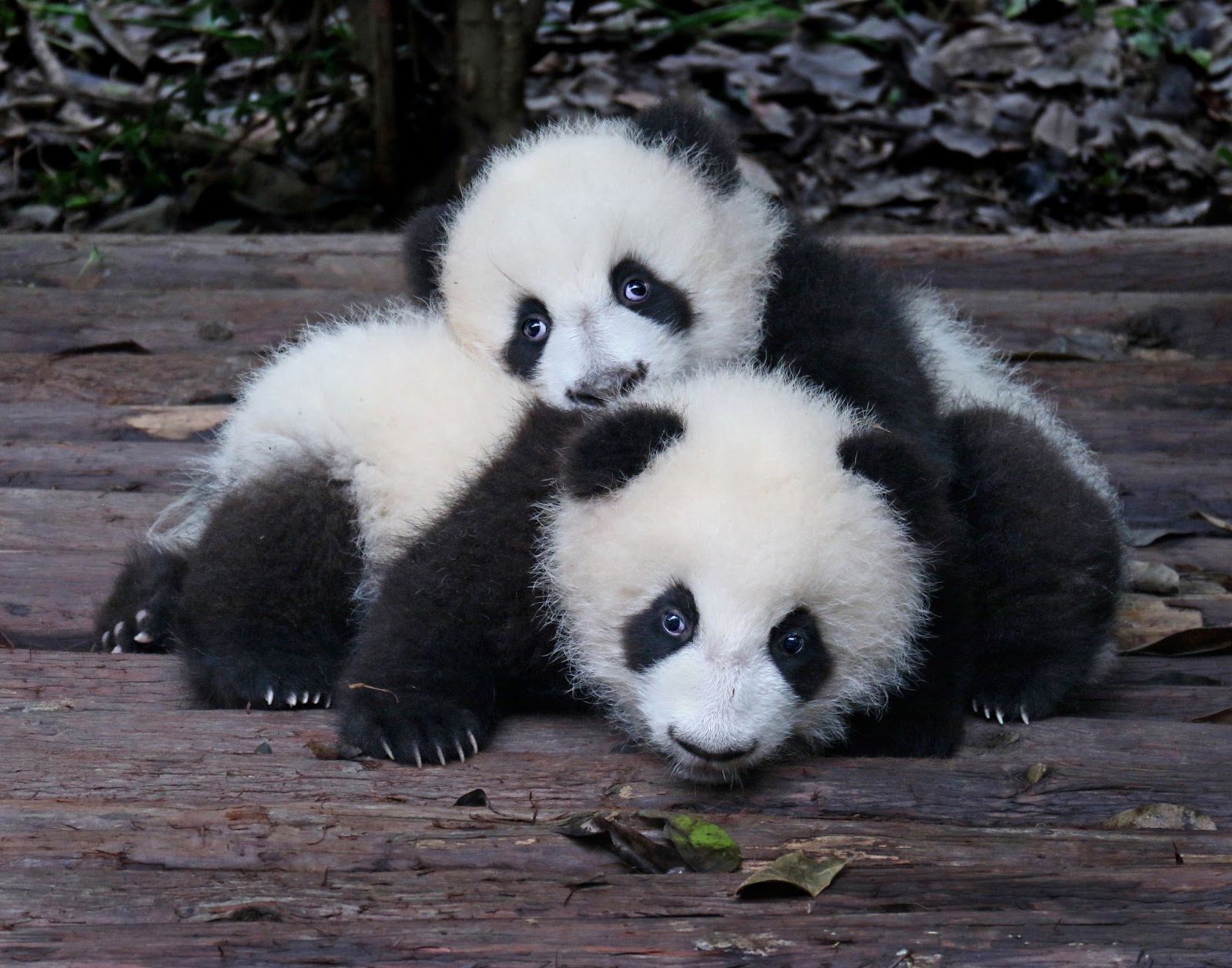
While males are more likely to use their body scents to mark their territories, females use them to communicate that they are interested in meeting someone and starting a family.
Under normal conditions, pandas become mature enough to breed between the age of four and eight. Interestingly, they may sustain the ability to reproduce for the rest of their lives.
Males are able to recognise the female’s scent and therefore propose to her. Sometimes, two and up to five male pandas get interested in the same female and may potentially fight each other to win her heart. By far, this could be the only occasion a panda will deliberately do excessive and aggressive physical behaviour.
Despite the panda’s lazy nature, fighting over a female is not surprising. This is called the survival instinct that is also found in all living organisms. This is how pandas guarantee their species will remain alive. The survival instinct is the same reason why we may get into fights to protect ourselves.
Pandas only mate once a year, and the mating season starts in the spring, typically in March, and lasts till May. A female panda stays pregnant for 3 to 5.3 months. This is quite a wide range for the pregnancy period. But it is usually this way because some stages of pregnancy may take longer than others.
Then, one or twin cubs are born in the fall, typically in August and September. Taking care of the cubs is the full responsibility of the mother. In contrast, the father does not really help with anything. That is why, if a mother has twins, it is common for her to choose the stronger of them to feed and leave the other one to starve.
While many may consider this a cruel act, it is just what the panda’s nature forces her to do. It is thought that the mother panda cannot feed both cubs simultaneously since her body does not usually produce sufficient milk.
Nursing twins would also consume a lot of the panda’s energy, something that the adult panda had already abandoned all physical activities to preserve.
This is quite a surprise and one of the unpleasant consequences of the panda abandoning its carnivorous nature. Normally, every female mammal produces the litter size it is definitely capable of taking care of no matter how hard it might seem.
For instance, a female rabbit’s litter size is five and up to 12 babies at a time. Despite her small size, the mother rabbit is totally able to care for all of them. On the other hand, the very little energy the panda gets from bamboo is barely sufficient for keeping her alive, maybe nursing a cub, but definitely not caring for two babies at the same time.
Having said that, if the panda is kept in captivity, humans usually take care of the twins. They provide the mother with more nutritious food to help her maintain and increase her milk supply.
Humans also regulate the feeding of the two babies. Sometimes, the captive mother panda might not even realise she had twins. That is because humans switch back and forth between them, giving the mother a chance to nurse both equally. They also provide the cubs with more care to help them survive and grow healthy.
Cubs
It is normal to expect newborns to be small or big based on the size of their mother. But for the giant panda, things seem to be a little odd, again.
Despite the panda being super large, with the female reaching the weight of 104 kg, her newborn cub is as light as 90 to 130 g. That is only 0.13% of the total weight of the mother, which is unbelievable compared to other species. For instance, an adult female panda is 25 times as heavy as an adult cat. Despite that, their newborns weigh the same!
The heaviest panda cub ever was born in August 2022 and weighed 270.4 g. For the panda, this is extraordinary.
Such a phenomenon is not exclusive to the giant panda but is something that all bears share. The female brown bear, which is five times as heavy as the female panda, usually gives birth to cubs that weigh only 0.15% of her weight. So far, it has not been understood why this is happening with the bears.
At birth, cubs look absolutely nothing like pandas, with their tiny pink bodies covered with fine, short, white hair. They are extremely helpless, blind, and can only crawl.
Mothers nurse their cubs between three and seven hours a day, divided into intervals of 30 minutes each. Two weeks after birth, the cubs’ white hair will gradually turn black while the pink skin will take a grey colour. By the age of one month, cubs will have developed the official black and white fur colour pattern of the panda.
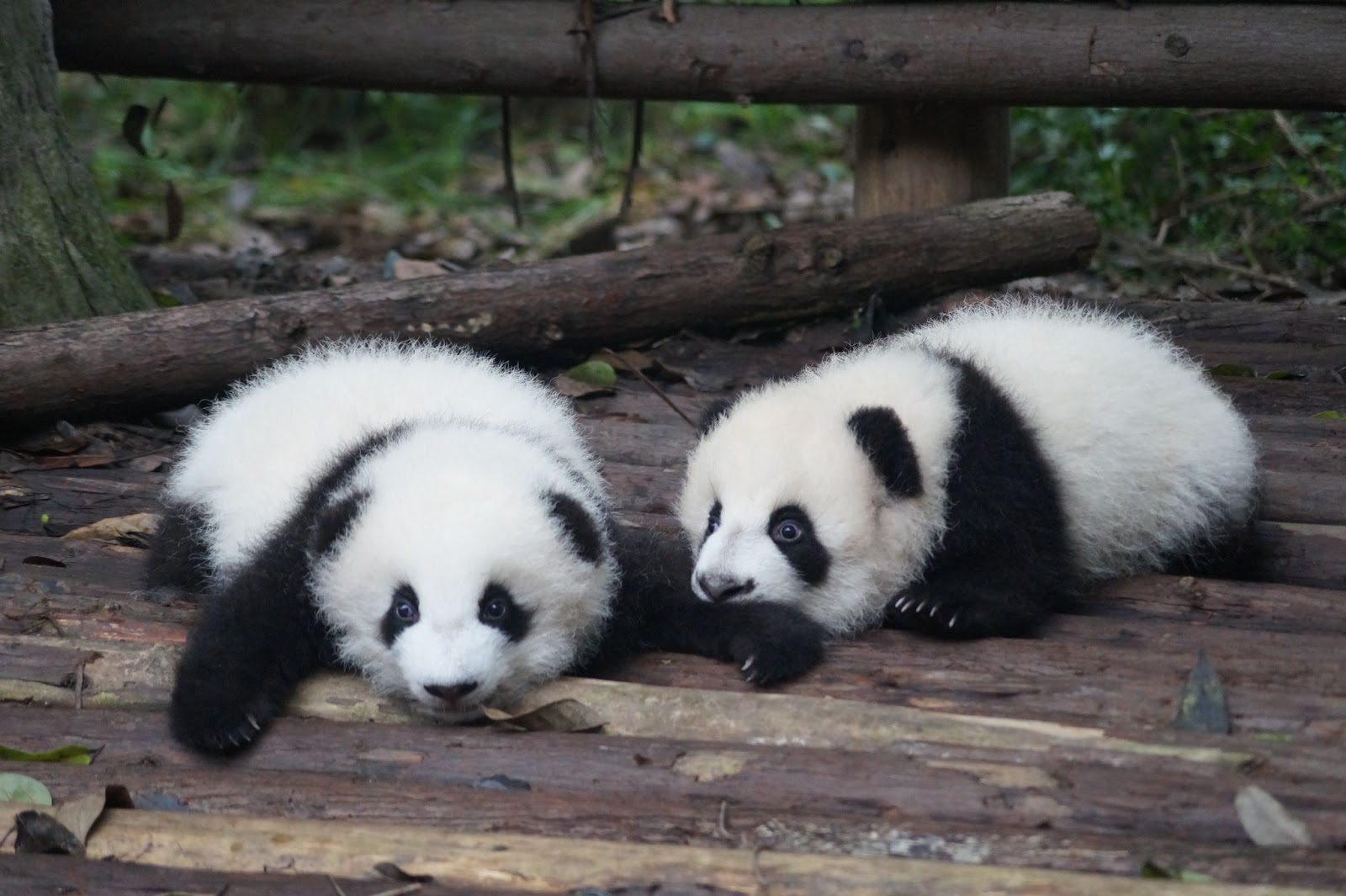
Mothers nurse their cubs for a year. Yet, they introduce them to their all-time favourite solid food, bamboo, before that. Usually, cubs can eat bamboo, at least in small quantities, only when they are six months old.
Panda cubs grow so fast that they weigh 45 kg, only at one year old. They stay with their mothers for six more months, or a year at maximum, and then they become entirely independent and move out. Only after the cubs have moved can the mother breed again.
In the wild, pandas usually have a lifespan of 20 years at maximum. But if they are kept in captivity, like in zoos where there are no threats and food is always available, pandas can live up to 30 years.
The world’s longest living panda, called An An, died at the age of 35 in July 2022 at the Ocean Park in Hong Kong.
Panda diplomacy
It seems like everyone spontaneously feels happy when they see a panda. Well, not only people but countries too. So if giving people presents can surely make them happy, gifting pandas to countries can help them get along.
As its national treasure, China had gifted many countries ‘goodwill’ pairs of pandas to show its desire to develop better diplomatic relationships with them. Since it is the only country pandas are native to and due to the bear’s utter cuteness, pandas as gifts worked effectively. This practice has been known as panda diplomacy.
Panda diplomacy is not exclusive to modern times. Scholars believe that China had been doing it since the seventh century up until recently. If this proves to be true, we can conclude that no Western country was ever gifted pandas before the mid-19th century since this was the first time the West knew pandas existed.
What is known for sure is that China used this practice more prominently and consistently for over 40 years, from 1941 to 1984.
Hsing-Hsing and Ling-Ling
One of the very famous panda gifts was given to the people of the United States in 1972. In February of the same year, US President Richard Nixon and First Lady Patricia Nixon went on an official visit to China.
During that visit, the US First Lady visited the Beijing Zoo, saw a small panda, and instantly fell in love with it. During the following dinner, the First Lady expressed how much she loved the panda she had seen earlier in the day.
So the Chinese statesman Zhou Enlai, on behalf of the Chinese people, gifted the United States two giant pandas named Hsing-Hsing and Ling-Ling.
Hsing-Hsing, a male, and Ling-Ling, a female, were a couple aged two and three at the time they were gifted. They arrived and stayed at the National Zoo in Washington, DC. The zoo received millions and millions of visitors each year who came from all across America to see the cute black and white Chinese bears.
The pair were well cared for and kept at a large panda house in the National Zoo. But despite that, none of the five cubs they had during their stay there survived.
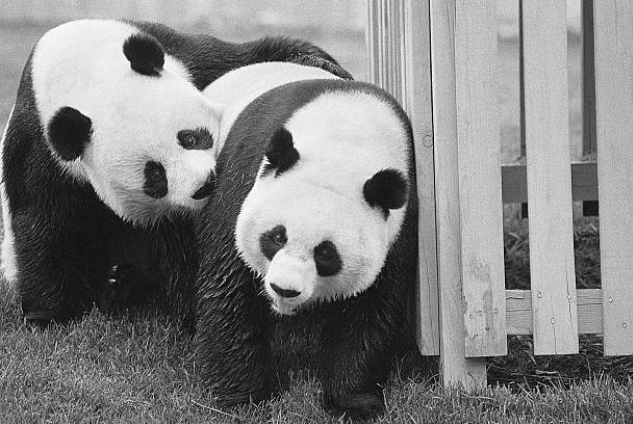
Hsing-Hsing and Ling-Ling stayed at the zoo until the early 1990s. In late December 1992, Ling-Ling suddenly died from heart failure. She was 23 years old at the time.
Hsing-Hsing was left lonely at the panda house until he died seven years later, precisely in November 1999, from kidney failure. Hsing-Hsing was 28 at the time of his death.
Thousands of people mourned the pandas and expressed their condolences to the zoo by sending letters of sympathy.
A year later, China sent a new couple, Mei Xiang and Tian Tian, to the US. They were one and two years old, respectively. When they arrived, they stayed at the same house as the previous couple and have been there since then.
Mei Xiang and Tian Tian are aged 24 and 25, respectively. So far, they have had a few cubs together. Though the pandas are currently living at the National Zoo, the cubs were sent back to China, according to the Chinese panda diplomacy policy.
Pandas have become very popular in the US, and sending them as gifts seems to have achieved its diplomatic goals. Many people believed in China’s good intentions and desire to build official relations with the United States.
Interestingly, the panda diplomacy success seemed to be contagious. The British Prime Minister, Edward Heath, asked for pandas when he was on an official visit in China in 1974. A few weeks later, the UK welcomed Chia-Chia and Ching-Ching, who were kept at the London Zoo.
Panda rental
From 1941 to 1984, China sent 24 pandas to many countries worldwide. But it seemed like such a practice had a harsh consequence on the species. First off, many of the gifted pairs did not breed. Even those who did lost their offspring, as none of them survived.
At the time, the population of pandas in mainland China started to decrease significantly. As we will see in a bit, pandas have been threatened majorly by habitat loss which dropped their numbers to 2000. So, starting 1984, pandas would be rented or ‘leased’ instead of gifted.
The first country to which the new policy was applied was the US. In 1984, China rented two pandas to the US to present at the 1984 Olympic Games, where each individual cost $50,000 per month.
Seven years later, in 1991, the policy was modified. Leases would be for 10 years, with each panda costing up to $1 million per year. There was also the condition that any cub born during the lease period would officially be the property of China and therefore be sent back home.
So the second panda couple that was sent to the National Zoo in Washington, unlike Hsing-Hsing and Ling-Ling, were probably not gifted but leased.
Such a policy has been applied ever since. Sending pandas was not always in exchange for money but also for other benefits. For instance, in 2008, a severe earthquake hit the Chinese province of Sichuan, which caused significant destruction to the city and left 60 pandas homeless. So China sent most of these pandas to other countries with which the Chinese government does business.
For instance, some of those homeless pandas were sent to Australia because it was supplying China with uranium.
China owns all the pandas currently living on Earth. And according to the 1984 lease policy, no country in the world can ever buy a panda unless China decides to change its policy.
Threats
Besides all the super traits the panda enjoys, it has been popular for being endangered; on the verge of extinction. So what caused this catastrophe? And how was the panda saved?
Well, it was partially because of the panda itself and partially because of us.
Usually, when animals live in the wild, they face different natural threats. Some of these are part of the cycle of life, such as predation. When bigger animals eat smaller ones, natural reproduction should usually keep the population stable.
Natural disasters can also cause the animals’ numbers to drop dramatically. Examples include wildfires, floods, droughts, volcanic eruptions, earthquakes, or tsunamis.
Other threats are sadly man-made. Humans have been more cruel than merciful toward nature. They cause harms that dramatically affect the balance of the ecosystem and cause animals and plants to disappear. To understand how devastating these harms are, we need to stop a little at the western black rhino.
The western black rhino
One of the most tragic examples of how humans harm nature is the extinction of the African western black rhino that was declared in 2011. That poor animal completely disappeared from the face of the Earth, like the dinosaurs. And if it were not for us, it would have still been alive.
The western black rhino did not go extinct all of a sudden. For 50 years before 2011, it had encountered lots of threats that eventually led to its disappearance. About 98% of the animal population in Africa was killed by poaching.
If you remember closely, poaching is the illegal killing of animals to take advantage of their body parts. And for the black rhino, its horns were so valuable that one kilo of them cost $20,000! It was believed to have healing powers, so it was used to make medicine.

Yet, what is more ridiculous is that most of those who bought the rhino horns only did it to show off their wealth and success. That is because the rhino horns were considered a status symbol in many social and professional networks.
And because they were so expensive, rhino horns were also given as gifts within those networks to strengthen business relationships.
In short, humans killed the entire population of an innocent animal only to show others how much money they had!
Although the rhino horn trade was banned and declared officially illegal back in 1977, poaching increased drastically. Greedy, heartless poachers killed 98% of the western black rhinos. Such mass killing only left a small number of the western black rhinos in the wild.
And since the western black rhino already had a relatively low reproduction rate, and breeding did require very favourable conditions, the population remained incredibly low. So the animal was declared critically endangered. Despite the efforts to save it, the last western black rhino died, and the species officially became extinct in 2011.
Now let’s go back to the panda.
As we have said, some of the panda’s threats are because of the panda itself, precisely in terms of the change in the panda’s diet and its complete dependence on bamboo. So any danger that may affect the availability of that food would genuinely put the bear at risk. And that is precisely what happened.
Habitat destruction
A panda requires at least two species of fresh bamboo to survive. Each panda also needs large amounts of bamboo every day. With each individual consuming up to 40 kg, a permanent supply of bamboo should always be available.
But during the second half of the 20th century, the Chinese population was growing so fast. So large areas of the panda’s habitat were cleared to build houses and cities for people to live in. They cut down trees, minimised the areas where pandas could live, and left them behind with less bamboo to sustain their diet.

In addition, it is also quite challenging for the panda to move to another forest or try to relocate. Apart from the pandas’ complete unwillingness to do that, thanks to their limited physical activity, forests have become separated by cities and roads.
As such practices continued and the availability of bamboo was reduced, the panda population dropped so dramatically over the past few decades that the bear was declared endangered in 1990.
Low reproduction rate
A second reason for the panda population decline is that breeding is pretty difficult.
Clearing the bamboo forests has split pandas into groups now living away from one another. This has imposed extra difficulty for males and females to find each other and mate.
Some also say that it is the mate acceptance that may delay the breeding process. As we have mentioned earlier, if pandas are in the wild, it is the female that gets to choose her mate from a group of males.
But in captivity, it is usually one male and one female. Just because a couple stays together in the same room does not necessarily mean they will be attracted to one another and mate.
Even if this happens and a couple finally accepts each other as bride and groom, timing is still super critical. A female panda is physically ready to breed in the spring. This readiness only lasts between one and three days at maximum.
If mating does not happen during this period, there is no chance for the female to get pregnant, and she will have to wait until she gets a new chance the year after.
In addition, as we have mentioned, 50% of the females that get pregnant successfully give birth to twins. In the wild, the mother sacrifices the weaker of the two and invests all her energy in the stronger cub.
This chosen cub, however, is so weak at birth. And as the mother panda needs to leave the den every now and then to feed and retrieve her energy, she leaves her cub completely defenceless. Cubs may be attacked by predators such as leopards. Even older cubs are prone to attacks from snow leopards and dogs.
Poaching
Another man-made threat that led the panda population to drop dramatically is poaching, the illegal killing of pandas to sell their body parts. For the panda, its precious black and white fur had attracted greedy, cruel poachers. So they happily killed the panda, endangered it, and pushed it too close to extinction just for money.
Unfortunately, pandas may also be accidentally killed when they fall into traps usually made to catch other wild animals.
Conservation
All the threats we have just mentioned have taken their toll on the poor panda. So its population dropped drastically to 1,114 individuals only and was declared endangered by the IUCN in 1990. As a result, serious conservation efforts were needed to save the panda from the inevitable fate of extinction.
In 2016, the panda’s conservation status was upgraded to vulnerable. Though that does not mean the panda is entirely safe, at least it is not as close to extinction as it was before. This also means there is hope that more efforts can help the population increase at a faster pace.
So what exactly happened that pushed the panda a little away from the verge of extinction?
Well, so many things happened. The panda has become even more famous due to the conservation efforts, campaigns, and awareness that have been made to help save it from extinction. Such efforts, in fact, started back in the 1940s, but they intensified in the 1980s when the pandas became critically endangered.
Building reserves
Before getting into more detail about panda conservation, we need to explain the difference between zoos and wildlife reserves, commonly known as national parks.
Animals are usually kept captive in zoos mainly to entertain people, educate them about wild animals, apply scientific research, and care for and breed them. No matter how large zoos can be, they are still confined areas where animals are usually kept in cages for display or rooms for rest.
On the other hand, reserves or national parks are vast, protected, natural areas, usually parts of the animals’ natural habitat. They allow the animals to live freely and entirely on their own, but they also protect them from man-made threats that may put them in danger.
Many people love to go to zoos to watch animals kept in super large cages. Others love to go on safari trips in national parks to enjoy watching wild animals in their natural habitats. In this case, it is the people who stay in protected cars to watch the animals while they are wandering here and there in the wild.
The Chinese government building reserves represented the first efforts to protect the panda and their natural habitat. Throughout the last few decades, China has successfully created 40 reserves. In some of these reserves, scientists conduct scientific research on the pandas to study their behaviour and find the best ways to help them breed.
Deforestation ban
In 1998, the Chinese government banned the destruction of the panda’s habitat, so cutting down the bamboo forests has become a punishable crime. This, along with the new reserves, has slowed down the decrease in the panda population.
In addition, the Chinese government has also built corridors to connect the separated areas of the pandas’ habitat to one another. This should make it a little easier for the panda to look for food in other areas.
Breeding programmes
To help with the panda’s poor reproduction, China has created and enrolled the panda in captive breeding programmes to facilitate the breeding process and increase the reproduction rate.
The first programme started back in the 1950s. However, it was not until the mid-1960s that the programme began to show some success. Ming Ming, the first panda, bred in captivity, was born in the Beijing Zoo in 1977.
As of January 2021, around 633 pandas were enrolled in breeding programs not only in China but all over the world. Compared to the 320 pandas enrolled back in 2016, this 2021 number is another great success.
Artificial insemination
While researchers make a lot of effort to get pandas interested in mating while in captivity and usually provide much care to help the cubs survive, this could be such a complicated process. As we said, it would take decades just to increase the population by only a few hundred individuals.
So scientists decided to use artificial insemination.
Usually, breeding happens by combining a sperm for the male with an egg from the female, and therefore a baby starts to grow. This combination occurs when the pandas mate.
As we mentioned, it can be extremely hard for the male panda to know the perfect time to mate with the female. But scientists do. So they take the sperm from the male and combine it with the egg from the female, then place these combined cells inside the female panda’s womb.
That said, artificial insemination, like natural breeding, has a low success rate. If you remember, from the panda breeding section, the female panda usually undergoes some pregnancy complications that slow down some of its stages. So scientists cannot tell whether a female panda got pregnant or not almost until she gives birth. And since the babies are usually tiny, even ultrasound cannot see them either.
Despite that, no one cannot deny the progress such programmes have made, despite how small it might be.
So thankfully, the panda population increased. And after 26 years, the panda was taken off the endangered list and declared vulnerable. In terms of numbers, 70 pandas were successfully bred and are now alive. The most recent estimates report that the current panda population has become 2060.
However, being vulnerable does not mean pandas are safe. In fact, they are still at risk of going extinct. But hopefully, with the continuation of the conservation efforts, maybe one day we will be able to save them.
Conclusion
Wow! That was a long and hopefully entertaining adventure in the world of the most loved mammal, the panda.
In this article, we discussed the extravagant existence of the giant panda. We talked a little about its ancestor, where its name came from, and in what way it is related to the red panda. We also looked into why it is called the living fossil and how it, as an apex predator supposedly residing on top of the food chain, has turned into a strict vegetarian eating low-in-nutrition bamboo.
Then, we explored the panda’s beautiful appearance and its striking black and white fluffy thick fur that protects the bear from the cold weather. Besides its round face, strong jaw, and broad teeth, the panda was blessed with a false thumb that allows it to hold the bamboo while eating.
After that, we learned how the panda gradually stopped eating meat and eventually became almost entirely dependent on bamboo for fuel. It was all thanks to a genetic mutation that prevented the panda from tasting meat.
Afterwards, we studied the panda’s breeding behaviour and how much of a difficult process it is. Then, we moved on to panda diplomacy and how it, as China’s national treasure, was used as a goodwill diplomatic gesture that helped China establish good relationships with many countries.
We also tackled the threats the panda has been facing for the past half-century, which eventually decreased its numbers dramatically and pushed it to the verge of extinction. It was not only the human-made threats that caused that. The panda’s sole food and its incredibly low reproduction rate have made the problem even worse.
Last but not least, we looked into the conservation efforts that have been made to help protect the panda. And while they have made some progress, there is still a long way to go to help the panda population become normal again.
We hope you found this article useful and interesting as much as we loved writing it for you. Tell us in the comments which part surprised you the most about the giant panda, which one you loved the most, and whether or not you have seen a panda in real life.
And until another lesson, stay safe and keep learning.
If you enjoyed learning about this facinating animal why not check out more fantastic facts about other animals: Koalas, Land Animals, Sharks, Raccoons, Moon and Sun Bears, Rats, Sheep, Chickens, Cats, Monkeys and Whales.
Why not subscribe to our LearningMole Library for as little as £1.99 per month to access over 1000 fun educational videos.


Leave a Reply